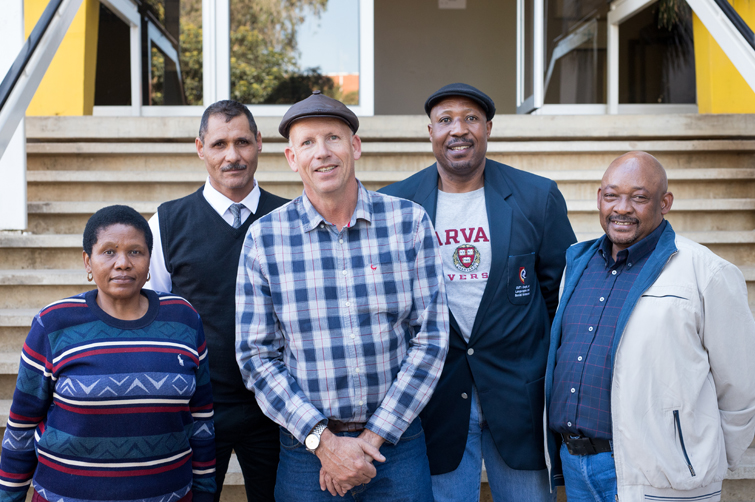Latest News Archive
Please select Category, Year, and then Month to display items
13 January 2020
|
Story Eugene Seegers
|
Photo Anja Aucamp
 Spearheading the digital expansion of the conversational Sesotho course is IDEAS Lab Director, Johann Möller (middle). With him are from the left: Prof Pule Phindane, CUT; Dr Brenton Fredericks, CUT; Bahedile Letlala, UFS Department of African Languages; and Dr Elias Malete, UFS Department of African Languages.
Spearheading the digital expansion of the conversational Sesotho course is IDEAS Lab Director, Johann Möller (middle). With him are from the left: Prof Pule Phindane, CUT; Dr Brenton Fredericks, CUT; Bahedile Letlala, UFS Department of African Languages; and Dr Elias Malete, UFS Department of African Languages.
For many years now, the UFS has been offering a one-year course in conversational Sesotho for staff members; this can then be followed up with the one-year course in advanced conversational Sesotho. The conversational Sesotho for students in the Faculty of Education was introduced in 2018 at the UFS.
The Central University of Technology (CUT) needed a conversational course for its first-year students and approached the Department of African Languages for the development of such a course. Living as we do in a multilingual country; this additional language skill opens doors and often hearts as well.
Using instructional design principles
However, the need was identified by both CUT and UFS to present this crucial information in a way that would be more appealing to digital natives as well as to those less familiar with technology. The Department of African Languages on the UFS Bloemfontein Campus, together with relevant departments from the CUT, approached the IDEAS Lab located on the UFS South Campus, since they already have a reputation for being a specialist on broadcasting and repackaging curricular content for digital presentations. The IDEAS Lab provided technical advice and built the multimedia programme, which will help the user to hear and practice phrases in Sesotho, using instructional design principles. The course will be available to both staff and students belonging to the two universities.
Room for growth
Johann Möller, Director of the IDEAS Lab, says this pilot programme will give both institutions the opportunity to test the use of multimedia for language acquisition. He adds, “Language is extremely complex, and we would like to expand this learning aid in the future.” In fact, the original design has room for growth built into it.
To keep things simple for the user and the building team, it was decided to start out with only four potential everyday scenarios where a staff member would like to speak Sesotho: Firstly, how to greet other persons from different genders; secondly, potential scenarios one might encounter in the university environment itself; thirdly, how to deal with situations at a hospital; and finally, how to use one’s language skills at a filling station.
Pronunciation is key
Each scenario contains three to four conversations that the learner can revise, along with images and audio that illustrate the situation and assist with correct pronunciation. The system does not allow the user to progress unless they have listened to the pronunciations of the sample sentences or phrases.
Further reading material and vocabulary lists are also provided, with the result that people who are using the programme can learn at their own pace. The authoring software Articulate Storyline was used to build the individual scenarios and each conversation or lesson within it. The lessons are also not dependent on an internet connection; they can be downloaded onto a flash memory drive and used offline.
Department of Architecture recognises excellence
2014-11-20

From the left are: Gary Westwood, Marius du Plessis and Henry Pretorius
Photo: Ifa Tshishonge
Front page design by Marius du Plessis |
Marius du Plessis received the first prize in the Regional Corobrik Student of the Year Award for his design of a National Geothermal Research and Educational Centre in Johannesburg. The award ceremony was hosted by the Department of Architecture at the University of the Free State.
Anja Lareman was awarded the second prize for her Psychiatric Unit for the Deaf in Worcester and Mariska Peel received third prize for her design of a laboratory for the after oil epoch in Durban.
The Corobrik award for Best use of clay masonry brickwork was awarded to Valentino Moutzouris for his design of a Performing Arts Centre in Wynberg, Cape Town.
The event was well attended by architecture students who hoped to take home an award. Projects exhibited, received distinctions in one or all of the three main components, including design, the architectural theoretical treatise and building sciences.
“This is the greatest award that one could win in the Free State. It came with so much blood, sweat and tears, as I had to live, eat and work day and night at the same place in order to finish the project,” said Marius, master’s student in Architecture. He said that he hopes the project can be developed and implemented in mine shafts to solve the energy crisis in South Africa.
Henry Pretorius, Academic Departmental Head of Architecture, said: “It is vital for architecture to have a public interface. This event is to showcase the work of students and to make sure that it is accessible to the public. It encourages students to understand the value of their own work and its cognisance to society.”
Gary Westwood, Sales Manager of Corobrik Free State, Northern Cape and Lesotho region, said: “So far it has been an incredible journey. This annual event of 24 years is our way of giving back to the community who supports and sustains our business. It is wonderful to see how the architecture industry has adapted to a more sustainable way of design, by being part of the green movement.”
Marius will compete with other Corobrik winners from various universities on national level in April 2015.